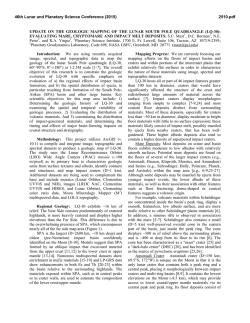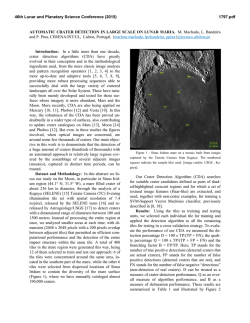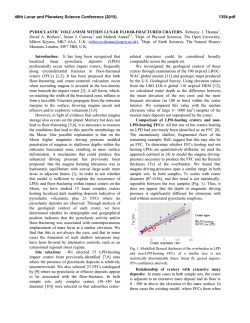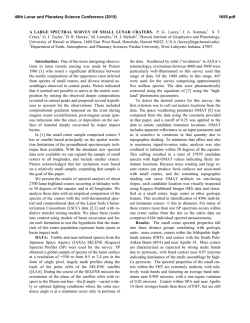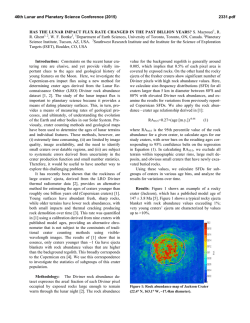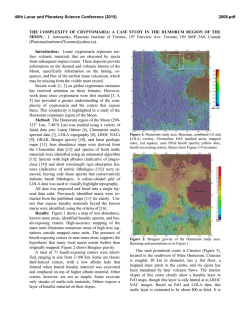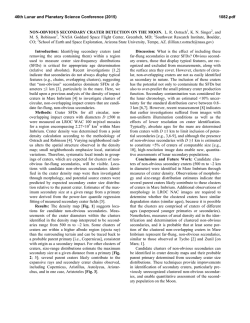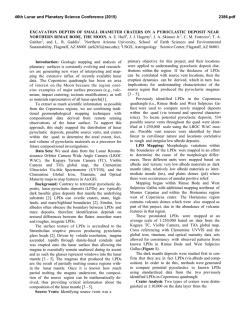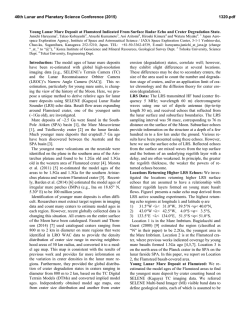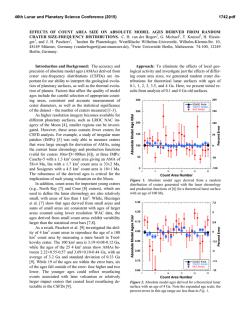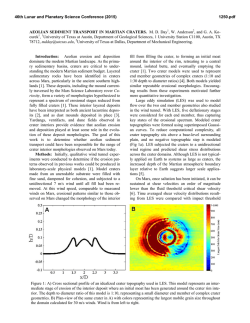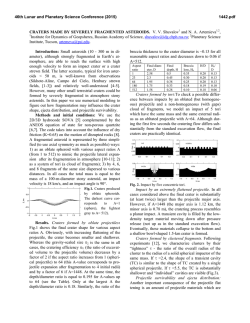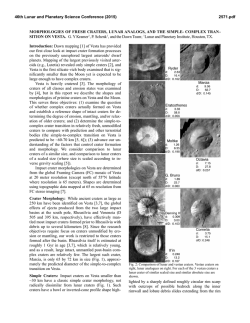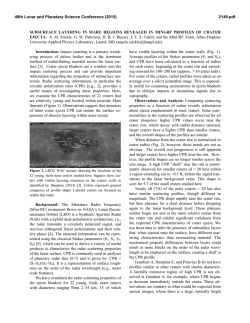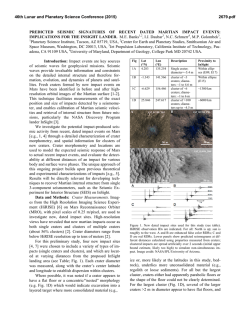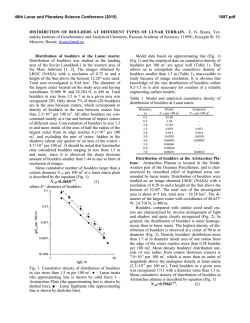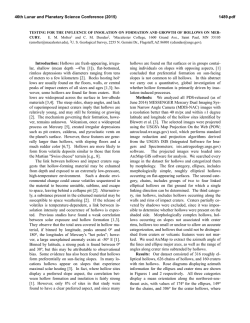
HOW OLD ARE SMALL LUNAR CRATERS ? - A DEPTH-TO
46th Lunar and Planetary Science Conference (2015) 1615.pdf HOW OLD ARE SMALL LUNAR CRATERS ? - A DEPTH-TO-DIAMETER RATIO BASED ANALYIS P. Mahanti1 , M.S. Robinson1 , R. Stelling1 1 Lunar Reconnaissance Orbiter Camera, School of Earth and Space Exploration, Arizona State University, Tempe,AZ,USA; [email protected]; Introduction: In contrast to the larger craters (D > 10km) and basins which shaped the baseline morphology of the Moon, small lunar craters (SLC) continue to form and modify the local topography of the Moon. SLCs form on and around larger craters and basins, are the most populous impact features on the surface but also the least studied - topographic data was available only for larger craters until recent missions (e.g. Lunar Reconnaissance Orbiter (LRO), Kaguya), carrying high resolution cameras (e.g. Lunar Reconnaissance Orbiter Camera (LROC) Narrow Angle Camera (NAC) [1], Selene Terrain Camera [2]). A clear understanding of degradation rates of SLCs can help ascertain the ages of the youngest craters of the Moon. Analysis of depth (d; rim-to-floor) to diameter (D; rim-to-rim) ratio for lunar craters is a well-established method for quantifying the morphological state (and thus relative age) of a crater. Following the event of crater formation, redistribution of mass both inside and outside the crater rim by various methods continuously d ratio was modifies the crater depth and diameter. The D used to broadly classify craters (simple and complex) [3, 4, 5] and also to study the evolution of craters [6]. In this work, we discuss and model the time-dependant of degradation state of SLCs by analyzing the populad tion density vs D for selected locations on the Moon. Further, we discuss the relationship of angle of repose (θ)(angle at which granular material begins to move und der the influence of gravity)and D for SLCs. A recent study [7] (20m < D < 200m) shows that d crater population decrease asymptotically with D ratio d and the probability distribution function (PDF) of D is a skewed bell-shaped curve (Figure 1). First, since the PDF is bell-shaped, the shape of the cumulative distribution function (CDF) is sigmoidal and can be modeled d using a known function from observed D values with no assumptions. Second, if the representative crater dataset contains almost all craters within a given range (an exhaustive dataset), then the CDF can lead to an understanding of the degradation rate for SLCs. Smaller craters (D < 200m) form a steady state population such that the craters disappear at the same rate as others are formed [8, 9, 10]. By assuming this equilibrium, the change in the cumulative population of craters can be re-written as [11] − ∂ d D ∂t = −R ∂N ∂ d D −1 (1) d Here N is a function of D and is the number of craters d with D greater than a given d/D value in the consid- Figure 1: Number of SLCs (PDF) at different Dd expressed as percentage of total population. Note the skewed bell-shape d bins are equally spaced (binsize nature of the distribution. D = 0.03) ered crater population. R is the crater production rate obtained from previous work (Neukum 2001, Hartmann 1999, Marchi 2009). The value of R can be obtained from previous work on crater production rate and was found to vary between 10−10 to 10−8 (cumulative number; per square km per year) [12]. Hence, an appropriate model for ∂∂Nd directly helps in the computation of the (D) d degradation rate (for a particular D and D), which takes us a step further in ascertaining the freshness of the observed SLC. Methods: Craters are identified manually from NAC ortho-photo image, the digital elevation model and a derived slope map. Details for obtaining measurements are same as in [7]. While a dataset obtained globally was used for comparison, the three regions considered in this work are Apollo 11, Apollo 16 and Apollo 17. Data acquired from these regions (obtaining measurements for all craters with D < 200m) represent a dynamic equilibrium of crater formation and crater degradation procedures. The PDF and d CDF were computed from observed D values. The classes A,AB,B,BC and C have the same description for bowl-shaped craters as found in earlier work [6]. Class A represents the freshest, steep sloped (> 35◦ ) craters, class B are moderately steep sloping craters (15◦ to 25◦ ) and class C are craters with shallow slopes (< 10◦ ). The other two classes are intermediate. There is a difference in the definition of N (number d d of craters with D greater than a given D value) and d the CDF (number of craters with D less than a given 46th Lunar and Planetary Science Conference (2015) Figure 2: Cumulative number of SLCs (CDF) at different d expressed as percentage of total population. D equally spaced (binsize = 0.03). d D bins are d D value). However, under the assumptions of an exhaustive dataset and expressing N as a fraction, the definition can be inverted via probability to express N in terms of the PDF (Figure 1). The PDF and CDF (Figure 2) can be obtained directly from observations by bind ning a range of D values (a bin size of 0.03 was chosen for this work).Further, a logistic distribution model was chosen to represent the PDF from which the parameters for CDF can be obtained. The expression for logistic d CDF (F(x); x is D ) is F (x; µ, s) = 1 1 + e− x−µ s (2) The parameters µ and s represent the shape of the CDF. Results and Discussion: The percentage of Class A SLCs is < 10% (Figure 2) but significantly higher than 1% as indicated in earlier work [6] due to observed d D (across multiple regions from which SLCs were idend tified) higher than 0.33. Higher D values were also d noted in another recent work [13]. SLCs with D values more than 0.33 also appear to have higher wall-slope stability from the angle-of-repose point-of-view. For SLCs the topographic profile is parabolic and the theoretical maximum slope occurs just below the rim. Then, d and the maximum slope are reit can be shown that D d tan θ lated as D ≤ 4 . For stability of the crater shape, θ should be less than or equal to the angle of repose, assuming a gravity regime. For the Moon, θ lies between 32◦ to 36◦ [14] for both highland and mare targets derived for larger diameter (20 km) craters. If the same d range is valid for SLCs, then D varies between 0.14 to 0.18 for a stable crater morphology after the crater ford mation event. As degradation occurs the D value (as well as the average wall slope) decreases. However, the d CDF obtained for D for the Apollo 11, 16, 17 show 1615.pdf d number of D above 0.18 suggesting that higher slopes (> 45) are maintained for a small percentage of SLCs. d value of 0.18 was selected in a recent work [11] AD d > 0.18 is due to material propWe interpret that D erties where the cohesive strength of regolith and (or) layering of regolith and bedrock maintain a wall slope greater than the angle of repose (gravity regime). Slopes greater than angle of repose is possible for more coherent non-granular material. The average time spent at any degradation phase is proportional to the observed population density (Figure 1) if a dynamic equilibrium is assumed in the SLC formation-degradation process. d > 0.18 condition is short lived and soon Thus, the D d d which is (a) same the D value reaches a value D θ (within a small standard deviation) for a given diameter range of craters and (b) correlates to angle of repose. d For example, a SLC may initially possess a D value of d 0.3, but the D ratio is reduced to the 0.14 to 0.18 range in a short period of time. Following this initial degrad dation, the D decreases at a slower pace (inferred from Figures 1 and 2), over a long period of time,till the SLC is obliterated. The CDF of SLCs was modeled using a logistic distribution function (model fitting R-squared value = 1). The values of µ for highland and mare SLCs were found to be different with mare values at 0.12 and highland values at 0.14. SLCs from Apollo 16 show µ values same as that for the highlands. The values of s is approximately 0.04 for both mare and highland SLCs suggesting similarity in the degradation process. From equation 1, if R is invariant, then the degradation rate for mare craters is lower compared to highland craters - possibly influenced by the relative depths at which bedrock is present in mare and highlands. References: [1] M. Robinson, et al. (2010) Space science reviews 150(1):81. [2] J. Haruyama, et al. (2006) Advances in Geosciences, Planetary Science 3:101. [3] R. Pike (1977) in Impact and Explosion Cratering: Planetary and Terrestrial Implications vol. 1 489–509. [4] R. Baldwin (1965) New York, McGraw-Hill [1965] 1. [5] C. Elachi, et al. (1976) Earth, Moon, and Planets 15(1):119. [6] A. Basilevskii (1976) in Lunar and Planetary Science Conference Proceedings vol. 7 1005–1020. [7] P. Mahanti, et al. (2014) in Lunar and Planetary Institute Science Conference Abstracts vol. 45 1584. [8] L. A. Soderblom (1970) Journal of Geophysical Research 75(14):2655. [9] E. M. Shoemaker (1965) in The Nature of the Lunar Surface vol. 1 23. [10] H. Moore (1964) 1964 34–51. [11] A. Basilevsky, et al. (2014) Planetary and Space Science 92:77. [12] M. Le Feuvre, et al. (2011) Icarus 214(1):1. [13] I. J. Daubar, et al. (2014) Journal of Geophysical Research: Planets. [14] R. Wagner, et al. (2013) in Lunar and Planetary Institute Science Conference Abstracts vol. 44 2924.
© Copyright 2025

